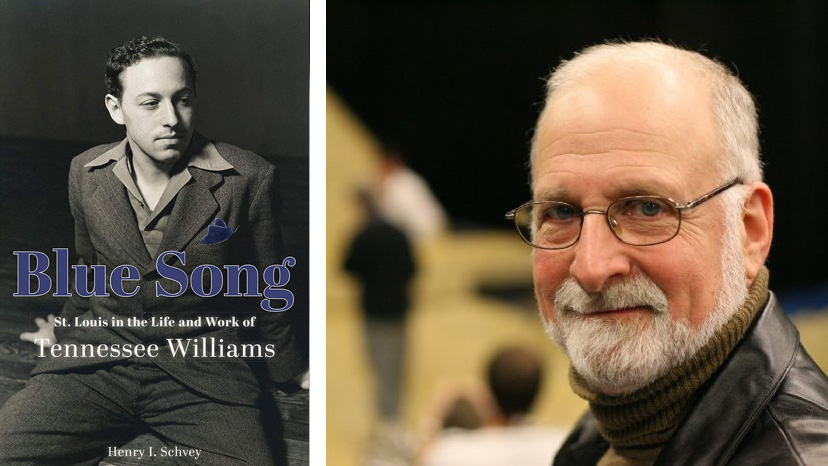Wash U professor’s new book looks at St. Louis’ impact on Tennessee Williams
Washington University professor Henry Schvey is the author of “Blue Song: St. Louis in the Life and Work of Tennessee Williams.”
Published July 1, 2021
Seventeen years ago, browsing in a New Orleans bookstore, Henry I. Schvey made a once-in-a-lifetime discovery: An unpublished, entirely unknown poem by Tennessee Williams.
Today, the title of that poem is the title of Schvey’s new book, “Blue Song: St. Louis in the Life and Work of Tennessee Williams” (University of Missouri Press, $40).
“I didn’t know it then,” said Schvey, professor of drama and comparative literature at Washington University. “But that poem (“Blue Song”) brought Tennessee Williams in St. Louis to life for me.
ADVERTISEMENT
“In some way, I identified.”
Washington University made the first, and most obvious, connection. Schvey, who is Jewish, has served on Washington University’s faculty for 34 years; Williams wrote the poem, by hand, in the “blue book” for his Wash U final in Greek.
In his journal the night before the exam, Williams sounded despondent. “I will undoubtedly flunk,” he predicted. He was right.
But the sad, lovely poem, evidently unnoticed by the Greek professor, instantly struck Schvey as “poignant and powerful.”
There are more connections, too, including a coincidence that Schvey only discovered while researching his book: He and the playwright once shared a Manhattan address, 15 West 72nd Street.
ADVERTISEMENT
A teenager then, Schvey lived with his family on the 25th floor. Williams lived on the 33rd. They didn’t know each other. Still, Schvey loves the idea that they may have shared a smile or a “hello” on the elevator.
The biggest coincidence, though, is that both of them embraced a New York-St. Louis trajectory — though in opposite directions.
The son of a father straight out of “Mad Men” and a mother who was an extreme hoarder, Schvey detailed his often-unhappy youth in a memoir, “The Poison Tree.” But things got better — especially after he met a classmate at the University of Wisconsin, Patty Cohn of University City. The Creve Coeur couple will be married 52 years in August.
When Schvey fell for her, he fell for her whole family — a close family whose members liked and supported each other. The couple was delighted to move to St. Louis for his job at Wash U, but also for the Cohns.
In time, Schvey explained, he developed a private emotional geography: New York, cold and exhausting; St. Louis, warm and expansive.
Williams’ emotional map was the exact opposite. That made for a rough life — but for great art.
For Williams, St. Louis was a heartless trap that would sooner or later destroy him, just as it destroyed his beloved sister, Rose. (She was subjected to a prefrontal lobotomy.) Yet it was here that he became a poet and a playwright, developing themes and imagery that he would continue to elaborate all his life.
“Nobody had really explored, comprehensively, what St. Louis meant to him,” Schvey said. “The idea that became the book — that he could never leave — I discovered that as I went along.
“He felt trapped.”
We may think we know a lot about Williams’ family, but our ideas come mostly from one play, “The Glass Menagerie.” And no question, it offers strong connections to the writer’s life. He even gave the son in the play his own real name, Thomas; “Tennessee” was Williams’ own invention.
But Cornelius Williams was a very different father from, say, Max Cohn. A violent drinker and gambler, Cornelius Williams lost part of an ear when another man bit it off in a poker fight. He and his wife, Edwina, had terrible arguments that frightened their children. Sometimes he beat her.
He mocked his son as “Miss Nancy,” pulled him out of the University of Missouri when he flunked ROTC and forced him to take a desk job at the company where he was a manager, International Shoe. (Eventually the young man returned to school, first at Wash U, then the University of Iowa.)
But the Williams family was never as poor as its theatrical counterpart, the Wingfields. In fact, they lived in comfortable apartments in the West End of St. Louis and University City. And Cornelius Williams never abandoned his family — unlike the father in the play that would rocket Tennessee Williams, by then a New Yorker, to fame.
Like his father, Tom Wingfield walks out on the mother and sister who depend on him. He escapes St. Louis, but not his memories of it. In fact, “Glass” is considered a “memory play,” one of the first and perhaps the very best of the genre. The drama is in part a love letter to the writer’s tragic sister, Rose, Schvey contends, but is “equally about the playwright’s quest to extricate himself from the prison of St. Louis.”
But, Schvey observes, Williams’ writing benefited from those terrible experiences — and from good experiences here, too. In particular, he found friends at Wash U, young men with whom he shared ideas about politics and art. And he began writing for a community theater troupe here, the Mummers.
The Mummers were “a controversial, daring community theater,” Schvey said, that encouraged Williams to write politically charged dramas such as “Not About Nightingales” (about prison conditions) and “Candles to the Sun” (about a miners’ strike).
“There is much more to these early plays than critics have thought,” Schvey said. “They have been dismissed as juvenalia. But these are really interesting plays!
“Even each of the little roles is a great character. That’s when you realize what a genius Williams was. Everything is precisely delineated. “
Those Mummers’ plays reveal Williams’ strong sympathies with the working class and the poor, and the leftist views he shared with his college friends. Today, however, we don’t associate that perspective with a writer we think of as lyrical, Southern, perhaps effete.
Furthermore, Schvey added, “we do the same thing, in reverse, with Arthur Miller,” the Jewish New Yorker who won the Pulitzer Prize in drama for “Death of a Salesman” in 1949. The year before, Williams won it for “A Streetcar Named Desire.”
We acknowledge the strong political and moral elements in Miller’s work because they seem to emerge from his biography, Schvey said, just as Williams’ biography seems to inspire vivid portraits of frail, unstable women like Laura Wingfield in “Glass” and Blanche DuBois in “Streetcar.” But that’s unfair to both playwrights, Schvey believes.
“We want writers to fit into round holes,” Schvey said, “even though artistic geniuses, almost by definition, are square pegs.
Over time, Williams became even harder to classify. The late plays — mainly surrealistic, depressing or both — never attracted the audiences that loved “Glass,” “Streetcar” and “Cat on a Hot Tin Roof.” Nevertheless, “he still wanted to be appreciated,” Schvey said. “He wanted to have plays on Broadway.
“But he was running out of gas. He burned himself out” with an excess of drink, drugs and casual sex. “He lived very hard. When he died (in 1983), he was ready to go.”
In his last years, Williams spent a lot of time in Florida’s Key West. There, he enjoyed swimming and painting — Schvey has already begun his next project, a study of Williams as painter — while he continued, as always, to write.
One thing he wrote was a will, with clear instructions about his burial. He asked to be buried at sea, in the Gulf of Mexico.
But his brother, Dakin Williams, brought the body back to land-locked St. Louis. Williams was buried beside his mother at Calvary Cemetery — a cemetery “synonymous with traditional St. Louis,” Schvey writes.
Many people have considered that an insult, defying the writer’s explicit wishes. But Schvey thinks that ultimately, it was perfect.
In his life and throughout his work, Williams endlessly tried to escape St. Louis, a place that he often disparaged and where he felt trapped by familial and societal expectations. Yet he kept coming back, sometimes in reality and always on the page.
“He was very good at escaping,” Schvey said, “until he wasn’t.”
















